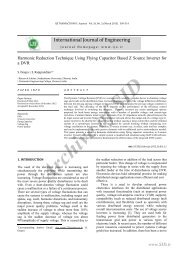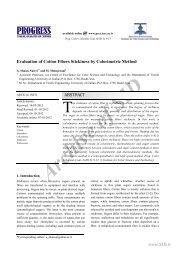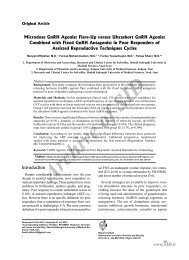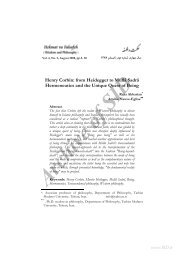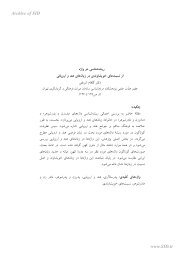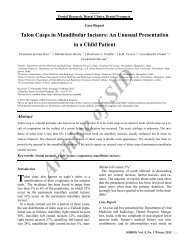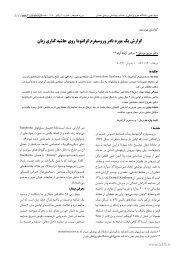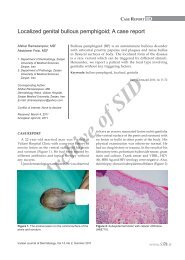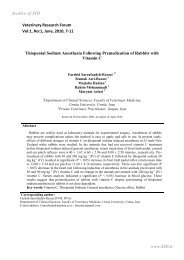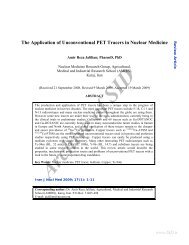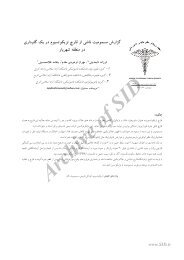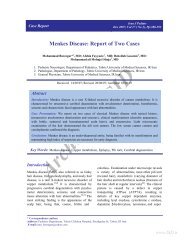THE EFFECTS OF CYNARA SCOLYMUS L. LEAF AND ...
THE EFFECTS OF CYNARA SCOLYMUS L. LEAF AND ...
THE EFFECTS OF CYNARA SCOLYMUS L. LEAF AND ...
Create successful ePaper yourself
Turn your PDF publications into a flip-book with our unique Google optimized e-Paper software.
The Effects of …<br />
extracts treatment to CCl4 intoxicated rats at<br />
10 and 20 times of human doses (THD) did<br />
not influence the liver toxicity, where as at<br />
higher doses i.e. 30 THD administration of<br />
these medicinal plants extracts attenuated the<br />
decrease in liver toxicity as indicated by serum<br />
liver enzymes level lowering effect and<br />
amelioration in histopathological changes in<br />
the liver tissue. However, we failed to observe<br />
any effect of C. scolymus leaf and C. intybus<br />
root extracts on liver tissue GSH level and<br />
catalase activities. The underlying mechanism<br />
for hepatoprotective effects of C. scolymus<br />
leaf and C. intybus root extract remains to be<br />
elucidated.<br />
In C. scolymus leaf extract several<br />
compounds such as cynarin, caffeic acid,<br />
chlorogenic acid, luteolin and other flavonoids<br />
and polyphenol compounds, some with<br />
antioxidant properties have been found [23-<br />
25]. Adzet T et al., reported that, the<br />
hepatoprotective effect of C. scolymus may be<br />
due to its chlorogenic acid and cynarin content<br />
[12] and other study proposed that, the<br />
protective effect of C. scolymus leaf extract on<br />
CCl4 induced acute liver injury may be due to<br />
its antioxidative property [25]. In C. intybus<br />
root a phenolic compound esculetin, is known<br />
for anti-hepatotoxic activity [10, 26]. Zafar R,<br />
and Mujahid Ali S. proposed that, the<br />
hepatoprotective effect of C. intybus root<br />
extract may be due to its ability to suppress the<br />
oxidative degradation of DNA in the tissue<br />
debris [13].<br />
Journal of Medicinal Plants, Volume 10,<br />
No. 37, Winter 2011<br />
Archive of SID<br />
However, in present study we observed the<br />
liver protective activity of C. scolymus leaf<br />
and C. intybus root extracts without significant<br />
effect on the liver tissue GSH level and<br />
catalase activity as markers of body antioxidative<br />
defense system. This indicate that<br />
the observed protective effects on CCl4<br />
induced liver injury in this study may not be<br />
due to anti-oxidative activities of the two<br />
38<br />
extracts only, as demonstrated in other studies<br />
[14, 22].<br />
Overall, to explain the observed<br />
hepatoprotective effects of C. scolymus leaf<br />
and C. intybus root extract in the present study,<br />
it is important to remember that following<br />
CCl4 induced acute liver injury; several<br />
important basic mechanisms such as reactive<br />
free radical metabolites formation, lipid<br />
peroxidation, covalent binding and disturbance<br />
of calcium homeostasis are involved in tissue<br />
damage [27]. In addition, inflammation and<br />
regeneration are other important modifying<br />
factors in the tissue injury [27]. However, the<br />
observed effects of C. scolymus leaf and<br />
C. intybus root extract against CCl4<br />
intoxication in present study may be due to the<br />
direct or indirect favorable effect of medicinal<br />
plants on liver cellular metabolism,<br />
inflammation and regeneration.<br />
Conclusion<br />
The present findings indicated that, the<br />
administration of C. scolymus L. leaf and<br />
C. intybus L. root extract at the doses of 900<br />
mg/kg/day and 450 mg/kg/day respectively or<br />
30 THD to CCl4 intoxicated rats, prevent liver<br />
toxicity and liver histopathological changes<br />
without significant influence on hepatic<br />
antioxidant properties. Further studies are<br />
required to evaluate the efficacy of combined<br />
administration of both medicinal plant extracts<br />
at different doses in experimental studies.<br />
Acknowledgements<br />
This study was supported by a research<br />
Grant # 1297-33-24/8/1388 from the ACECR<br />
Deputy Research Tehran, Iran. We thank the<br />
administration of the Institute of Medicinal<br />
Plants for their support in providing the<br />
necessary facilities for conducting this study.<br />
www.SID.ir



